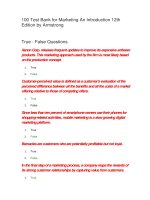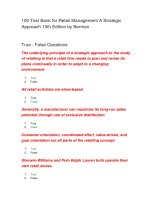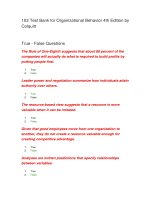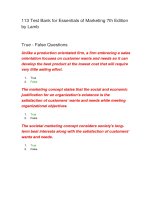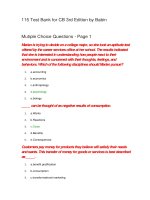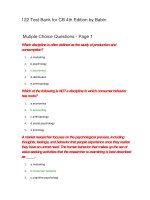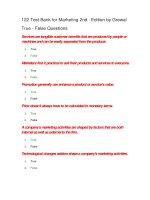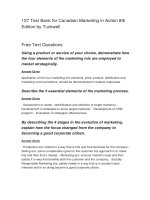122 test bank for marketing 2nd edition by grewal đề trắc nghiệm marketing
Bạn đang xem bản rút gọn của tài liệu. Xem và tải ngay bản đầy đủ của tài liệu tại đây (187.85 KB, 39 trang )
122 Test Bank for Marketing 2nd Edition by Grewal
True - False Questions
Services are tangible customer benefits that are produced by people or
machines and can be easily separated from the producer.
1.
True
2.
False
Marketers find it practical to sell their products and services to everyone.
1.
True
2.
False
Promotion generally can enhance a product or service's value.
1.
True
2.
False
Price doesn't always have to be calculated in monetary terms.
1.
True
2.
False
A company's marketing activities are shaped by factors that are both
internal as well as external to the firm.
1.
True
2.
False
Technological changes seldom shape a company's marketing activities.
1.
True
2.
False
Marketers can deliver greater value to consumers by treating the four Ps
as separate components rather than configuring them as a whole.
1.
True
2.
False
Marketing mix is the controllable set of activities that a firm uses to
respond to the wants of its target markets.
1.
True
2.
False
Product-oriented companies focus on whether the products best satisfy
customers' needs.
1.
True
2.
False
Ideas include thoughts, opinions, philosophies, and intellectual concepts
that cannot be marketed.
1.
True
2.
False
Companies with a selling orientation tend to focus on building long-term
customer relationships.
1.
True
2.
False
Marketing helps in jump-starting the economies of less developed
countries by actually putting buyers and sellers together to create new
markets.
1.
True
2.
False
The process of identifying customer segments that the company wants to
target with its products and services requires market research.
1.
True
2.
False
A marketing plan is broken down into various components and specifies
the marketing activities for a specific period of time.
1.
True
2.
False
Some companies engage in both B2B and B2C marketing at the same
time.
1.
True
2.
False
Multiple Choice Questions - Page 1
A company manufactures soaps. It selects a small number of retail outlets
to distribute the product. This is an example of ___________ of the four Ps
of marketing.
1.
people
2.
price
3.
place
4.
product
5.
promotion
The communication that informs, persuades, and reminds potential
buyers about a product or service to influence their opinions or elicit a
response is the ___________ component of the four Ps of marketing.
1.
people
2.
price
3.
place
4.
product
5.
promotion
Since women constitute 90 percent of Karen's, a pharmacy chain's,
customers, the chain decided to implement changes that would make the
shopping experience more pleasant for them. Karen introduced shorter
wait-times, wider and better-lit passageways, and more beauty products.
Women constitute Karen's:
1.
primary commodity market.
2.
primary target market.
3.
primary currency market.
4.
secondary target market.
5.
niche market.
All the activities necessary to get a product from the manufacturer or
producer to the right customer when that customer wants it make up the
___________ component of the four Ps of marketing.
1.
people
2.
price
3.
place
4.
product
5.
promotion
A commercial roofing company provides commercial roofing services. It
also provides residential roof repair and replacement. The residential
market provides solid revenue and constitutes the:
1.
primary commodity market.
2.
primary target market.
3.
primary currency market.
4.
secondary target market.
5.
niche market.
A major sports goods company distributes its products via retailers. It
offers attractive subsidies on its products to encourage retailers to sell
higher volumes. This is an example of ___________ of the four Ps of
marketing.
1.
people
2.
price
3.
place
4.
product
5.
promotion
Bank International was created to provide the working class with a means
of saving. The bank accepts all deposits between $1 and $500. The bank
encourages people who save a very small amount every month to
continue to save. This is an example of:
1.
C2C marketing.
2.
C2B marketing.
3.
B2B marketing.
4.
B2C marketing.
5.
D2R marketing.
Art World conducts art contests for kindergarten classes across many
schools. Art World encourages parents and siblings to be involved in
these contests to encourage and support participants. Parents and
siblings constitute the:
1.
primary commodity market.
2.
primary target market.
3.
primary currency market.
4.
secondary target market.
5.
niche market.
The trade of things of value between the buyer and the seller so that each
is better off as a result is referred to as:
1.
demand.
2.
want.
3.
exchange.
4.
necessity.
5.
need.
A trader in the market trades his goods for the money that is paid for the
goods offered by him. This is an example of:
1.
demand.
2.
want.
3.
exchange.
4.
necessity.
5.
need.
A company specializes in rock climbing. It aims its advertisements at men
and women who are between the ages of 18 and 50. It also aims at
overworked executives and people in managerial positions who need to
get away from their jobs. These two categories constitute the ___________
for the company.
1.
commodity market
2.
stock market
3.
target market
4.
currency market
5.
artificial market
A company is concerned with developing an efficient system for
merchandise to be distributed in the right quantities, to the right locations,
and at the right time in the most efficient way. It is making:
1.
people decisions.
2.
price decisions.
3.
place decisions.
4.
product decisions.
5.
promotion decisions.
The process of selling merchandise or services from one business to
another is referred to as:
1.
C2C marketing.
2.
C2B marketing.
3.
B2B marketing.
4.
B2C marketing.
5.
D2R marketing.
The process in which businesses sell to consumers is referred to as:
1.
C2C marketing.
2.
C2B marketing.
3.
B2B marketing.
4.
B2C marketing.
5.
D2R marketing.
Jane wants to buy a bike. She spends a lot of time and energy trying to
find the right bike. She does find one and then pays $200 to buy it. The
time and energy spent along with the sum of money constitutes the:
1.
idea.
2.
good.
3.
service.
4.
exchange.
5.
price.
Mir Air is one of the largest airlines operating in the world. It provides
scheduled and charter air transport for passengers to 200 destinations
worldwide. Together with its regional partners, the airline operates on
average, more than 1,500 scheduled flights daily. This is an example of:
1.
B2C marketing.
2.
D2R marketing.
3.
B2B marketing.
4.
C2C marketing.
5.
C2B marketing.
An accountant preparing financial statements must use a pencil to make
all calculations and an eraser to correct errors. Pencils and erasers are
examples of:
1.
ideas.
2.
goods.
3.
services.
4.
exchange.
5.
price.
A fast-food restaurant aiming to attract children between the ages of 4 and
10 creates a tempting menu and cheerful environment. Since children are
always accompanied by adults, the restaurant creates a separate,
soundproof play area to give the parents some quiet time. The fast-food
centre is now popular even with grandparents. Parents and grandparents
are the:
1.
primary commodity market.
2.
primary target market.
3.
primary currency market.
4.
secondary target market.
5.
niche market.
A non-governmental organization provides food and shelter to people who
make their living on the streets. Food and shelter are included in the
definition of:
1.
demand.
2.
want.
3.
exchange.
4.
necessity.
5.
need.
Which of the following holds true for the term goods?
1.
It refers to tangible customer benefits that are produced by people or machines
and can be separated from the producer.
2.
It refers to intangible customer benefits that are produced by people or machines
and cannot be separated from the producer.
3.
It refers to the overall sacrifice a consumer is willing to make in terms of money,
time, and energy in order to acquire a specific product or service.
4.
It refers to thoughts, opinions, philosophies, and intellectual concepts that also can
be marketed.
5.
It refers to the groups of people who need or want a company's products or
services and have the ability and willingness to buy them.
Which of the following holds true for the term price?
1.
It refers to the tangible customer benefits that are produced by people or
machines and can be separated from the producer.
2.
It refers to the intangible customer benefits that are produced by people or
machines and cannot be separated from the producer.
3.
It refers to the overall sacrifice a consumer is willing to make in terms of money,
time, and energy in order to acquire a specific product or service.
4.
It refers to thoughts, opinions, philosophies, and intellectual concepts that also can
be marketed.
5.
It refers to the groups of people who need or want a company's products or
services and have the ability and willingness to buy them.
A company manufactures and sells baby products targeting new moms
and dads, grandparents, and people who go to baby showers.
Grandparents constitute the company's:
1.
primary commodity market.
2.
primary target market.
3.
primary currency market.
4.
secondary target market.
5.
niche market.
A toy store's reduced prices have successfully attracted children over the
years. The toy store has traditionally offered lower prices than other
stores and was also the first to expand into the suburbs and crowded
downtown areas of large urban cities. Children are the toy store's:
1.
secondary target market.
2.
niche market.
3.
primary currency market.
4.
primary commodity market.
5.
primary target market.
The customer segment or group to whom a firm is interested in selling its
products and services is a(n):
1.
commodity market.
2.
stock market.
3.
target market.
4.
currency market.
5.
artificial market.
A feeling of physiological deprivation of the basic necessities of life, such
as food, clothing, shelter, or safety is a(n):
1.
demand.
2.
want.
3.
exchange.
4.
necessity.
5.
need.
The particular way in which a person chooses to satisfy the requirement
for any of the basic necessities of life is a(n):
1.
demand.
2.
want.
3.
exchange.
4.
necessity.
5.
need.
One main purpose of marketing is to create value by:
1.
hiring the right people for the promotion of the products being manufactured.
2.
informing potential buyers about a product or service.
3.
fixing the measure of sacrifice that a customer is willing to make in order to
acquire a specific product.
4.
developing a variety of offerings, including goods, services, and ideas, to satisfy
customer needs.
5.
delivering the product on offer to the customer.
An automobile manufacturer buys tires, glass for windscreens, and rubber
hoses for its vehicles. The suppliers of these products are other
companies that specialize in the manufacturing of this equipment. This is
an example of:
1.
B2C marketing.
2.
D2R marketing.
3.
B2B marketing.
4.
C2C marketing.
5.
C2B marketing.
Human beings require clothes to cover their bodies. Some of them may
wear designer clothes, while others may pick up cloth from the flea
market. This example illustrates different ways to satisfy a basic
requirement of life and describes the concept of:
1.
demand.
2.
want.
3.
exchange.
4.
necessity.
5.
need.
An artist in an opera performs for the benefit of the audience. The live
performance of the artist would be termed a(n):
1.
idea.
2.
good.
3.
service.
4.
exchange.
5.
price.
A daycare business provides babysitting services as well as structured
preschool education and learning stimulation. This is an example of:
1.
B2C marketing.
2.
D2R marketing.
3.
B2B marketing.
4.
C2C marketing.
5.
C2B marketing.
Which of the following holds true for the term services?
1.
It refers to the tangible customer benefits that are produced by people or
machines and can be separated from the producer.
2.
It refers to the intangible customer benefits that are produced by people or
machines and cannot be separated from the producer.
3.
It refers to the overall sacrifice a consumer is willing to make in terms of money,
time, and energy in order to acquire a specific product or service.
4.
It refers to thoughts, opinions, philosophies, and intellectual concepts that also can
be marketed.
5.
It refers to the groups of people who need or want a company's products or
services and have the ability and willingness to buy them.
Sports Inc., a global sports brand, wants to deliver an effective campaign
across many markets. The company wants to effectively engage the youth
across key markets in Europe, and the campaign's main objective is to
generate awareness about the company. These efforts are made by Sports
Inc. to attract the youth, as they constitute the company's:
1.
primary commodity market.
2.
primary target market.
3.
primary currency market.
4.
secondary target market.
5.
niche market.
92 Free Test Bank for Marketing 2nd Canadian Edition
by Grewal Multiple Choice Questions - Page 2
Which of the following holds true for market-oriented companies?
1.
They try to sell as many of their products as possible rather than focus on making
products consumers really want.
2.
They focus on giving their customers better worth (monetary and non-monetary)
for the products than their competitors.
3.
They focus on developing and distributing innovative products with little concern
about whether the products best satisfy customers' needs.
4.
They focus on the extension of a single brand name to market products in different
product categories.
5.
They focus on what consumers want and need before they design, make, or
attempt to sell their products and services.
For this tennis academy, girls between the ages of 11 and 16 constitute
the:
1.
primary commodity market.
2.
primary target market.
3.
primary currency market.
4.
secondary target market.
5.
niche market.
Which of the following holds true for customer relationship management
(CRM)?
1.
It helps a company to allocate resources and is used as an analytical tool in brand
marketing, product management, strategic management, and portfolio analysis.
2.
It is a strategic performance management tool that can be used by managers to
keep track of the execution of activities by the staff within their control and to
monitor the consequences arising from these actions.
3.
It is a set of strategies, programs, and systems that focus on identifying and
building loyalty among the firm's most valued patrons.
4.
It is a framework for industry analysis and business strategy to determine the
competitive intensity and, therefore, the attractiveness of a market.
5.
It is a system of processes that enables organizations to centrally manage
deployment of surveys while dispersing authoring and analysis throughout an
organization.
The use of Internet tools to easily and quickly create and share content to
foster dialogue, relationships, and personal identities is referred to as:
1.
broadcast advertising.
2.
print media marketing.
3.
social media marketing.
4.
out-of-home marketing.
5.
visual merchandising.
Hi Design is a company that allows customers to have a unique
experience in that they can open a virtual "shop" that includes an online
storefront. This virtual shop also offers other facilities such as website
hosting, order management, fulfillment, payment processing, and
customer service. The products uploaded by customers can be bought by
people visiting the website. This "shop" is an example of:
1.
C2C marketing.
2.
C2B marketing.
3.
B2B marketing.
4.
B2C marketing.
5.
D2R marketing.
Drakes manufactures dirt bikes. The company makes products and sells
them in the market, as many as it can. It does not focus on the needs of
the customer. This is an example of:
1.
sales orientation.
2.
value orientation.
3.
market orientation.
4.
product orientation.
5.
brand orientation.
Mychoice, a social shopping website, launched a marketing platform that
enables shoppers to recommend purchased products to their friends.
Friends discover these recommendations through Facebook, Twitter,
email, and the Mychoice website and search engine. This is an example
of:
1.
C2B marketing.
2.
D2R marketing.
3.
B2B marketing.
4.
Page 6 of 21C2C marketing.
5.
B2C marketing.
A sales agent is paid a commission for each sale that she makes. She
convinces the customer to buy the product by describing its benefits, and
then she receives her commission. The customer is of little concern to
her. This is an example of:
1.
transformational marketing.
2.
transactional marketing.
3.
live-in marketing.
4.
relational marketing.
5.
optimal marketing.
An automobile manufacturer maintains a database of when and how
repeat customers buy its products, the options they choose, the way they
finance the purchase, and so on. This database enables the company to
understand customers and make offers that appeal to them. Because of
this initiative, a long-term bond is established between the buyer and
seller. This is an example of:
1.
transformational marketing.
2.
transactional marketing.
3.
live-in marketing.
4.
relational marketing.
5.
optimal marketing.
The group of firms and set of techniques and approaches firms use to
make and deliver a given set of goods and services is commonly referred
to as a(n):
1.
value chain.
2.
demand optimization.
3.
inventory control.
4.
demand chain.
5.
supply chain.
Home Cook is a company that sells recipe books. It has almost 100
uploads in YouTube. The main video is from the company's star
customers who explain how the recipe books have made their lives a lot
easier. This is an example of:
1.
visual merchandising.
2.
print media marketing.
3.
out-of-home marketing.
4.
social media marketing.
5.
broadcast advertising.
Blur Associates is a company that sells gaming consoles. It has
developed a Facebook fan page that provides interesting discussion
topics. This is an example of:
1.
broadcast advertising.
2.
print media marketing.
3.
social media marketing.
4.
out-of-home marketing.
5.
visual merchandising.
A coffee shop attempted to discover what customers really wanted from
their coffee-drinking experience. It found that people liked to chat over
their cup of coffee without anybody disturbing them. Therefore, the coffee
shop allowed its customers to stay as long as they liked, without requiring
them to order a new cup of coffee every 20 minutes to stay in the shop.
This is an example of:
1.
value orientation.
2.
brand orientation.
3.
product orientation.
4.
market orientation.
5.
sales orientation.
Each link in the supply chain is out for its own best interest in a:
1.
transformational orientation.
2.
transactional orientation.
3.
live-in orientation.
4.
relational orientation.
5.
optimal orientation.
Which of the following holds true for value-oriented companies?
1.
They focus on selling as many of their products as possible rather than focus on
making products consumers really want.
2.
They focus on giving their customers better worth (monetary and non-monetary)
for the products than their competitors.
3.
They focus on developing and distributing innovative products with little concern
about whether the products best satisfy customers' needs.
4.
They focus on the extension of a single brand name to market products in different
product categories.
5.
They focus on what consumers want and need before they design, make, or
attempt to sell their products and services.
A TV network company launched a Facebook application for users. This
application allows the users to create their own sports bar and grill. The
gamers can serve foods and soft drinks in their bars. This is an example
of:
1.
broadcast advertising.
2.
print media marketing.
3.
social media marketing.
4.
out-of-home marketing.
5.
visual merchandising.
Mary buying an iPod from Tom on eBay is an example of:
1.
B2C marketing.
2.
D2R marketing.
3.
B2B marketing.
4.
C2C marketing.
5.
C2B marketing.
A martial arts training institute has uploaded quick two-to three-minute
training tutorial videos on YouTube in order to advertise the institute. This
is an example of:
1.
secondary merchandising.
2.
social media marketing.
3.
out-of-home marketing.
4.
broadcast advertising.
5.
print media marketing.
Bagged is a leading producer of travel bags. It uses blogging sites to
connect with its customers and has daily updates about new marketing
trends. This is an example of:
1.
visual merchandising.
2.
print media marketing.
3.
out-of-home marketing.
4.
social media marketing.
5.
broadcast advertising.
Home Bakers introduced a new cake in the market. It was created as a
product to be sold and not based on what customers wanted at that time.
Therefore, the company concentrated on selling and paid little attention to
the question as to whether it best satisfied customers' needs. Home
Bakers is a:
1.
product-oriented company.
2.
sales-oriented company.
3.
market-oriented company.
4.
value-oriented company.
5.
brand-oriented company.
An online Internet marketing company attempts to sell consumers a
number of different products. It attempts to sell software to consumers
and other businesses to meet their needs. It has created products that are
based on the assumption that the product will meet the need of the
business or individual, whether or not they have expressed a need for the
product. This is an example of a:
1.
brand-oriented company.
2.
market-oriented company.
3.
sales-oriented company.
4.
value-oriented company.
5.
product-oriented company.
A company sells cars of a single colour and boast that the cars have many
innovative features. The company refuses to change the colour of the car
irrespective of the desire of the public to have a different-coloured car.
This is an example of:
1.
sales orientation.
2.
value orientation.
3.
market orientation.
4.
product orientation.
5.
brand orientation.
Fly Air offers credit-card flyer miles for a flight. If a Fly Air flight is late, the
company gives the miles back to the customer without the customer even
having to complain. Therefore, Fly Air has maintained excellent customer
satisfaction ratings. This policy creates long-term bonds with passengers
and makes them loyal to the company. This is an example of:
1.
relational marketing.
2.
transactional marketing.
3.
transformational marketing.
4.
live-in marketing.
5.
optimal marketing.
Heaven Hotels is a hotel chain that treats its customers like family. The
company further influences its bond with customers with its quality of
staff, reliability, consistent overall high quality, and global social
responsibility programs. This is an example of:
1.
transformational marketing.
2.
transactional marketing.
3.
live-in marketing.
4.
relational marketing.
5.
optimal marketing.
A certain wine retailer sells what it calls QPR wines. QPR refers to quality
price ratio. It simply means getting the best quality wine for the lowest
possible price. The wine retailer would be an example of a:
1.
brand-oriented company.
2.
market-oriented company.
3.
sales-oriented company.
4.
value-oriented company.
5.
product-oriented company.
Which of the following types of companies focus on each transaction
rather than building long-term customer relationships?
1.
cause-oriented companies
2.
value-oriented companies
3.
market-oriented companies
4.
sales-oriented companies
5.
product-oriented companies
Which of the following holds true for sales-oriented companies?
1.
They try to sell as many of their products as possible rather than focus on making
products consumers really want.
2.
They focus on giving their customers better worth (monetary and non-monetary)
for the products than their competitors.
3.
They focus on developing and distributing innovative products with little concern
about whether the products best satisfy customers' needs.
4.
They focus on the extension of a single brand name to market products in different
product categories.
5.
They focus on what consumers want and need before they design, make, or
attempt to sell their products and services.
The process in which consumers sell to other consumers is referred to
as:
1.
C2C marketing.
2.
C2B marketing.
3.
B2B marketing.
4.
B2C marketing.
5.
D2R marketing.
Which of the following regards the buyer–seller relationship as a series of
individual sales, so anything that happened before or after the sales is of
little importance?
1.
referral marketing
2.
transactional orientation
3.
live-in marketing
4.
relational orientation
5.
influence marketing
Which of the following is a requirement for making a firm value-driven?
1.
self-contained independent units with little capacity to influence or be influenced
2.
high-priced goods with more emphasis on branding than quality control
3.
innovative product range with low emphasis on customers' needs
4.
5.
sharing information about customers and competitors across one's own
organization
one-time transactional interaction rather than building relationships with customers
The time and energy spent along with the sum of money constitutes the:
1.
idea.
2.
good.
3.
service.
4.
exchange.
5.
price.
Terliss manufactures passenger car and automobile tires. It offers radial
and tubeless tires to dealers and automobile companies. This is an
example of:
1.
C2C marketing.
2.
C2B marketing.
3.
B2B marketing.
4.
B2C marketing.
5.
D2R marketing.
Amateur tennis enthusiasts constitute the:
1.
primary commodity market.
2.
primary target market.
3.
primary currency market.
4.
secondary target market.
5.
niche market.
These two categories constitute the ___________ for the company.
1.
commodity market
2.
stock market
3.
target market
4.
currency market
5.
artificial market


